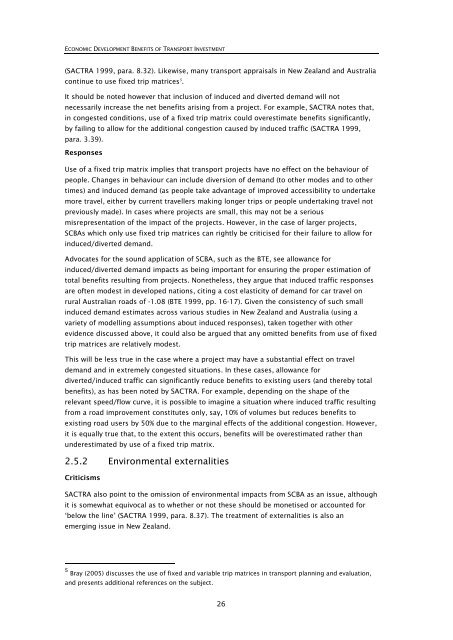Research 350 - NZ Transport Agency
Research 350 - NZ Transport Agency
Research 350 - NZ Transport Agency
You also want an ePaper? Increase the reach of your titles
YUMPU automatically turns print PDFs into web optimized ePapers that Google loves.
ECONOMIC DEVELOPMENT BENEFITS OF TRANSPORT INVESTMENT<br />
(SACTRA 1999, para. 8.32). Likewise, many transport appraisals in New Zealand and Australia<br />
continue to use fixed trip matrices 5 .<br />
It should be noted however that inclusion of induced and diverted demand will not<br />
necessarily increase the net benefits arising from a project. For example, SACTRA notes that,<br />
in congested conditions, use of a fixed trip matrix could overestimate benefits significantly,<br />
by failing to allow for the additional congestion caused by induced traffic (SACTRA 1999,<br />
para. 3.39).<br />
Responses<br />
Use of a fixed trip matrix implies that transport projects have no effect on the behaviour of<br />
people. Changes in behaviour can include diversion of demand (to other modes and to other<br />
times) and induced demand (as people take advantage of improved accessibility to undertake<br />
more travel, either by current travellers making longer trips or people undertaking travel not<br />
previously made). In cases where projects are small, this may not be a serious<br />
misrepresentation of the impact of the projects. However, in the case of larger projects,<br />
SCBAs which only use fixed trip matrices can rightly be criticised for their failure to allow for<br />
induced/diverted demand.<br />
Advocates for the sound application of SCBA, such as the BTE, see allowance for<br />
induced/diverted demand impacts as being important for ensuring the proper estimation of<br />
total benefits resulting from projects. Nonetheless, they argue that induced traffic responses<br />
are often modest in developed nations, citing a cost elasticity of demand for car travel on<br />
rural Australian roads of -1.08 (BTE 1999, pp. 16-17). Given the consistency of such small<br />
induced demand estimates across various studies in New Zealand and Australia (using a<br />
variety of modelling assumptions about induced responses), taken together with other<br />
evidence discussed above, it could also be argued that any omitted benefits from use of fixed<br />
trip matrices are relatively modest.<br />
This will be less true in the case where a project may have a substantial effect on travel<br />
demand and in extremely congested situations. In these cases, allowance for<br />
diverted/induced traffic can significantly reduce benefits to existing users (and thereby total<br />
benefits), as has been noted by SACTRA. For example, depending on the shape of the<br />
relevant speed/flow curve, it is possible to imagine a situation where induced traffic resulting<br />
from a road improvement constitutes only, say, 10% of volumes but reduces benefits to<br />
existing road users by 50% due to the marginal effects of the additional congestion. However,<br />
it is equally true that, to the extent this occurs, benefits will be overestimated rather than<br />
underestimated by use of a fixed trip matrix.<br />
2.5.2 Environmental externalities<br />
Criticisms<br />
SACTRA also point to the omission of environmental impacts from SCBA as an issue, although<br />
it is somewhat equivocal as to whether or not these should be monetised or accounted for<br />
‘below the line’ (SACTRA 1999, para. 8.37). The treatment of externalities is also an<br />
emerging issue in New Zealand.<br />
5 Bray (2005) discusses the use of fixed and variable trip matrices in transport planning and evaluation,<br />
and presents additional references on the subject.<br />
26
















